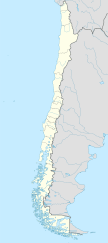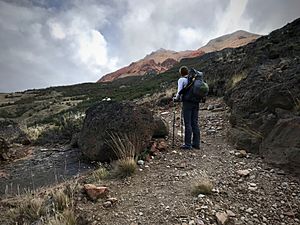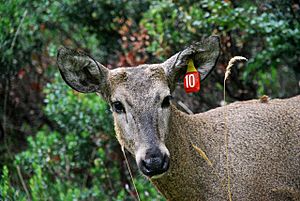Patagonia National Park (Chile) facts for kids
Quick facts for kids Patagonia National Park |
|
|---|---|
|
IUCN Category II (National Park)
|
|

Lago Verde, Sector Jeinimeni, Patagonia National Park
|
|
| Location | Aysén Region, Chile |
| Area | 3,045.28 km2 (1,175.79 sq mi) |
| Designation | National park |
| Designated | 2018 |
| Governing body | National Forest Corporation (CONAF) |
Patagonia National Park (Spanish: Parque Patagonia) is a huge national park in Chile. It is located in the Aysén Region. This amazing park used to be a private nature reserve. It was run by a group called Tompkins Conservation. In 2018, they gave the park to the Chilean government.
The park's main area is the Chacabuco Valley. This valley is very important for nature. It stretches from east to west across the Andes Mountains. It connects the dry Patagonian steppe grasslands of Argentina with the wet Magellanic subpolar forests of Chile. The park is found between General Carrera Lake to the north and Cochrane Lake to the south. It reaches the Argentinian border on its eastern side. The park has many trails, places to camp, and a visitor center.
Parque Patagonia was created by Conservacion Patagonica. This group was started in 2000 by Kris Tompkins. Their goal was to protect Patagonia's wild lands and animals. Conservacion Patagonica later joined with Tompkins Conservation.
On January 29, 2018, Chilean President Michelle Bachelet and Kris Tompkins signed a special paper. This paper created five new national parks. Patagonia National Park was one of them. Parque Patagonia was given to Chile. Then, it was combined with Lago Jeinimeni National Reserve, Lago Cochrane National Reserve, and other lands. This created the large Patagonia National Park. Its total size is about 640,000 acres (259,000 ha).
Contents
How Patagonia National Park Was Created
The project to create Patagonia National Park had four main goals. These were buying land, bringing back wildlife, building places for visitors, and working with local communities.
Buying Land for the Park
The Chacabuco Valley was once a very large sheep ranch. It changed owners many times over the last 100 years. In 1908, an explorer named Lucas Bridges started the ranch here. Later, in 1964, the land was divided among local families. Then, in 1980, it was sold to a Belgian landowner.
Kris and Doug Tompkins first saw the Chacabuco Valley in 1995. The Chilean National Forest Corporation (CONAF) had wanted to protect this valley for over 30 years. This was because it had many special natural areas. In 2004, Tompkins Conservation bought the 174,500-acre (70,600 ha) ranch. They also bought smaller pieces of land nearby. Their plan was to connect these lands. This would create a large protected area next to the Jeinimeni and Lago Cochrane (Tamango) national reserves.
Bringing Back Wildlife
The Chacabuco Valley was a big sheep and cattle ranch for many years. At one point, almost 25,000 animals lived there. This caused damage to the native grasslands. The soil became like a desert in some places. Wild animal populations also went down. After buying the ranch in 2004, Tompkins Conservation started to fix the land. They removed fences and planted native grasses. This helped animals like the guanaco and the endangered huemul deer return. Helping the huemul deer is a main goal. There are only about 100-200 huemul deer in the park. This is one of the largest groups left in the world.
- Restoring the Ecosystem:
Patagonia has suffered from too much sheep ranching. This has led to widespread desertification. Tompkins Conservation wanted to fix this damage. They aimed to bring back healthy habitats. They also wanted to show how to restore an ecosystem. The grassland recovery program started in 2004. They first removed almost all the farm animals. Volunteers helped a lot with this work. By 2011, they had removed over half of the 640 kilometers (400 mi) of fences. These fences used to break up animal habitats. Volunteers also collected seeds from native grasses. These seeds were used to replant damaged areas.
- Helping Animals Recover:
Tompkins Conservation's work helps many animals. Now, a group called Rewilding Chile continues this work. As the wildness returns, animal populations are getting healthier. With no farm animals, grasslands grow better food for plant-eating animals. These animals can also move freely without fences. The huemul deer is the top animal to protect in the park. There are only about 1,500 huemul deer left on Earth. This is due to losing their homes, diseases from farm animals, hunting, and attacks by pet dogs. Scientists track pumas with GPS collars. This helps them learn about puma hunting habits. This information is important because pumas live near huemul deer. The park also uses special dogs to protect farm animals from predators.
Building Places for Visitors
One main goal was to build good places for visitors. This would make visiting the park comfortable and interesting. They built a park headquarters. It has places to stay overnight, a restaurant, a museum, and a visitor center. The buildings are made to look like old Patagonian homes. They use local materials like stone and recycled wood. This makes them strong and easy to care for.
The park also has a special energy system. It uses solar, wind, and mini-hydro power. This makes the park the first in the world to produce its own energy. It also helps reduce its carbon footprint. They built trails and campgrounds too. These let visitors explore the wild parts of the park. They also connect to nearby reserves. By offering fun activities, the park helps eco-tourism grow. This supports local businesses and teaches people to respect nature.
Working with Communities
From the start, the park worked with nearby communities. They wanted more local people to visit the park. They also wanted to offer jobs to people living nearby. This helps create a good eco-tourism economy as the park grows. By involving children and others, the park hopes to inspire conservation.
Tompkins Conservation offered jobs to all the former ranch workers (gauchos). They also trained them to be park rangers and conservation workers. A school program brings local children to the park. They learn about endangered animals like the huemul deer. They also learn how conservation can help their community. The park hosts an annual Huemul Festival and hike. Huemul scholarships have helped over 50 students continue their education.
Park Ecosystems
Patagonia National Park is in a special area. It is between the dry Patagonian steppe of Argentina and the wet Magellanic subpolar forests of Chile. Because of this, the park has many different ecosystems. These include grasslands, riparian forests (forests along rivers), and wetlands.
The dry grasslands of Argentine Patagonia get little rain. They have cold, dry winds and sandy soil. The Andes Mountains block moisture from reaching this area. Many plants have learned to live in this tough environment. These include shrubs like calafate and tuft grasses. These grasslands are home to animals like the burrowing owl, gray fox, tuco-tuco, mara, and armadillos. You can also see eagles, hawks, and pumas here. More animals live on the edges of the desert. They also live around lakes formed by water from the Andes. Here, trees and better grasses can grow.
As you go west and higher into the Andes Mountains, the plants and animals change. The land turns into forests. These forests mostly have three types of southern beech trees. They are lenga, ñire, and coiue. It rains a lot here, making dense forests. These forests have many nutrients from fallen leaves. They are home to 370 types of plants. These plants are very important for the animals. Some important mammals include the endangered huemul deer, puma, red fox, and different kinds of bats. The park's forests also have many bird species. These include the Andean condor, Magellanic woodpecker, spectacled duck, black-necked swan, and Chilean flamingo. There are also many amphibians and reptiles.
The guanaco is a large animal related to the llama. It is the most common plant-eating animal in Patagonia. It eats 75% of all plant types in the Patagonian steppe. The guanaco is a very important species. It stops one type of grass from taking over. It also spreads seeds and helps fertilize the soil. Guanacos have many babies, which provides food for meat-eating animals, especially pumas.
Even though the park is on the eastern side of the Andes, its rivers flow to the Pacific Ocean. These rivers are fed by glaciers. Their turquoise blue water is home to many native fish. These include perch, pejerrey patagonico, and puyen. Some fish like Atlantic salmon, brook trout, brown trout, and rainbow trout have also been brought to the area.
Visiting the Park
Parque Patagonia is open from October to April. You can only reach it by car. It is south of Coyhaique and north of Cochrane, Chile. The closest airport is Balmaceda (BBA). From Balmaceda, it is a 300 km drive on the Carretera Austral to reach the park. As of March 2018, only part of this highway is paved. The rest of the road to the park is unpaved. The ranger station in Sector Jeinimeni is easy to reach by car. It takes about 1.5 hours from the town of Chile Chico. You can hike along the Aviles Trail to the Lodge at Valle Chacabuco. This hike takes 2 to 5 days.
The Lodge at Valle Chacabuco is in the middle of the park. It has the main visitor buildings. These include a lodge, a restaurant, a visitor center, and housing for park workers. There are also three campgrounds in the park.
Patagonia National Park in the Media
- Our Great National Parks is a Netflix documentary series. It is narrated by Barack Obama. This park was shown in its second episode, "Chilean Patagonia."
Images for kids
See also
 In Spanish: Parque nacional Patagonia (Chile) para niños
In Spanish: Parque nacional Patagonia (Chile) para niños






